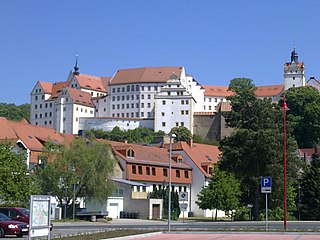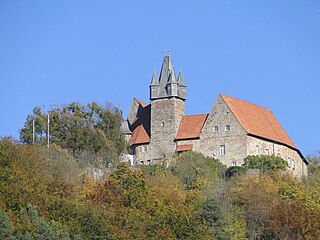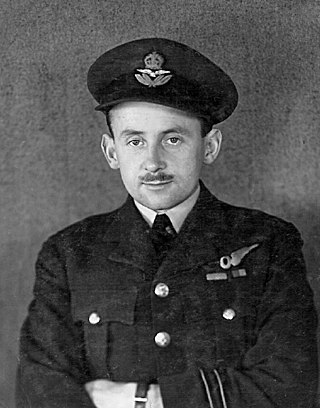
Colditz is a small town in the district of Leipzig, in Saxony, Germany. It is best known for Colditz Castle, the site of the Oflag IV-C POW camp for officers in World War II.

Colditz Castle is a Renaissance castle in the town of Colditz near Leipzig, Dresden and Chemnitz in the state of Saxony in Germany. The castle is between the towns of Hartha and Grimma on a hill spur over the river Zwickauer Mulde, a tributary of the River Elbe. It had the first wildlife park in Germany when, during 1523, the castle park was converted into one of the largest menageries in Europe.
Giles Samuel Bertram Romilly was a British communist journalist, Second World War POW, brother of Esmond Romilly, and nephew of Winston Churchill through his wife Clementine Churchill.

The Colditz Story is a 1955 British prisoner of war film starring John Mills and Eric Portman and directed by Guy Hamilton. It is based on the 1952 memoir written by Pat Reid, a British army officer who was imprisoned in Oflag IV-C, Colditz Castle, in Germany during the Second World War and who was the Escape Officer for British POWs within the castle.
Patrick Robert Reid, was a British Army officer and author of history. As a British prisoner of war during the Second World War, he was held captive at Colditz Castle when it was designated Oflag IV-C. Reid was one of the few to escape from Colditz, crossing the border into neutral Switzerland in late 1942.

Colditz is a British television drama series co-produced by the BBC and Universal Studios and screened between 1972 and 1974.
Bibliography of Colditz Castle is a list of works about Colditz Castle, its history as POW camp Oflag IV-C, the attempts to escape Oflag IV-C and many prisoners memoirs.
Colditz is a city in Saxony, Germany.

Oflag IV-C, often referred to by its location at Colditz Castle, overlooking Colditz, Saxony, was one of the most noted German Army prisoner-of-war camps for captured enemy officers during World War II; Oflag is a shortening of Offizierslager, meaning "officers' camp".

Oflag VII-C was a World War II German prisoner-of-war camp for officers located in Laufen Castle, in Laufen in south-eastern Bavaria from 1940 to 1942. Most of the prisoners were British officers captured during the Battle of France in 1940. To relieve overcrowding, some of the officers were transferred to Oflag VII-C/Z in Tittmoning Castle. The Oflag existed only for a short time. In early 1942 all the officers were transferred to Oflag VII-B in Eichstätt.

Prisoner of War is a 2002 third-person stealth video game developed by Wide Games and published by Codemasters. It follows the story of Captain Lewis Stone, a downed American pilot who must escape numerous prisoner of war camps and return home.
Patrick Palles Lorne Elphinstone Welch,, known as Lorne Welch, was a British engineer, pilot and Colditz prisoner of war.
Prisoners made numerous attempts to escape from Oflag IV-C, one of the most famous German Army prisoner-of-war camps for officers in World War II. Between 30 and 36 men succeeded in their attempts - exact numbers differ between German and Allied sources. The camp was situated in Colditz Castle, perched on a cliff overlooking the town of Colditz in Saxony.
Captain Kenneth Lockwood was a stockbroker and an officer in the British Army. He was one of the first six British prisoners of war to arrive at Oflag IV-C, Colditz, in 1940. He made and assisted in numerous escape attempts, working with the chairman of the escape committee, Pat Reid, and was still at the castle when it was liberated by the US Army in April 1945. He was the honorary secretary of the Colditz Association for 50 years.
Machiel van den Heuvel was a Dutch army officer. As a prisoner-of-war in Oflag IV-C at Colditz Castle, Germany, during World War II, he served as Escape Officer for the Dutch POWs, a role also held by Captain Pat Reid, the author of The Colditz Story, for the British. Van den Heuvel played a key role in most Dutch officer escapes during the war.

Colditz is a two-part 2005 television drama miniseries, based on the book Colditz: The Definitive History by Henry Chancellor, and the Channel 4 television series Escape from Colditz. It is not claimed to be historically accurate. It features an ensemble cast headlined by Damian Lewis and Sophia Myles and was directed by Stuart Orme. The screenplay was written by Peter Morgan and Richard Cottan.

Oflag IX-A was a World War II German prisoner-of-war camp located in Spangenberg Castle in the small town of Spangenberg in northeastern Hesse, Germany.

Dominic Bruce, was a British Royal Air Force officer, known as the "Medium Sized Man." He has been described as "the most ingenious escaper" of the Second World War. He made seventeen attempts at escaping from POW camps, including several attempts to escape from Colditz Castle, a castle that housed prisoners of war "deemed incorrigible".
The Birdmen, also known as Escape of the Birdmen and Colditz: Escape of the Birdmen, is a 1971 television film directed by Philip Leacock and starring Doug McClure and René Auberjonois. It was a fictionalized account based on a proposed scheme for prisoners of war to escape from Colditz Castle by a clandestinely constructed glider christened the Colditz Cock. The film appeared on the ABC Movie of the Week on September 18, 1971. The film was shot at Universal Studios Hollywood and released theatrically in several countries.











